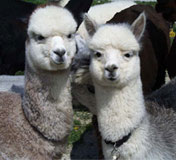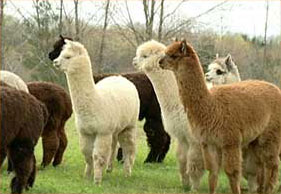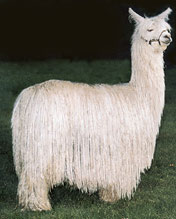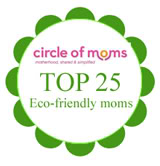3 question interview with Jim of SafeHouse Farm Alpacas
 When it comes to natural fibers, one of our personal favorites is alpaca. Holding the fiber feels like holding air!
When it comes to natural fibers, one of our personal favorites is alpaca. Holding the fiber feels like holding air!
No chemicals are employed either during feeding or during the industrial production of alpaca fleece into fiber. If dying is desired, only 20% of a normal dye quantity is required.
All fiber from an alpaca can be used. Fiber from the lower legs, belly, neck, etc is being used for things such as natural weed mats to be placed around trees. Alpaca fiber is biodegradable.
Alpacas require no insecticides, herbicides and fertilizers which pollute the groundwater.
And the feel…
Anyway, in honor of National Alpaca Farm Days this Saturday and Sunday, we interviewed Jim Tomaszek of SafeHouse Farm Alpacas in Barrington, IL
1. Please talk about the impact on the environment of raising alpacas compared to other “farm” animals.
Alpacas come from the Andes Mountains so they are very familiar with harsh conditions and a limited food supply. Indeed, their fiber has developed to address this environment.
Alpacas are hardy, they have a two toe cushioned pad rather than hooves or claws and do not compact the soil as heavier animals do. They are ruminates (three compartment stomach) and chew their food rather than bite it and pull it up by the roots. They have a mandible – no upper teeth. They take all the nutrients out of the grass or hay. As a result, their manure is virtually odorless and contains excellent micronutrients rather than large quantities of nitrogen, etc.
 To raise chickens, for example, you need hundreds to make a profit. Chickens smell, are susceptible to some nasty diseases, and neighbors are often unhappy with a chicken farm near them. We can say the same for pigs. As for cattle, they are large, are tough on pastures, you need lots of acreage and they are not usually child friendly.
To raise chickens, for example, you need hundreds to make a profit. Chickens smell, are susceptible to some nasty diseases, and neighbors are often unhappy with a chicken farm near them. We can say the same for pigs. As for cattle, they are large, are tough on pastures, you need lots of acreage and they are not usually child friendly.
As for alpacas, you can put 4-5 on a few acres, they are gentle on the soil, they do not eat or drink a lot, and children and grandchildren can lead them easily, once trained (the alpacas, not the kids !).
Alpacas are one of the least expensive start up home businesses around. All you need is a few acres and a love of animals. Right now breeding stock is where most of the profits come from although you can pay for the feed of your herd selling finished goods.
If you are wearing cotton, you are wearing pesticides and herbicides necessary to produce a bumper crop for the farmer. If you are wearing nylon you are wearing oil products. Wool? It takes harsh chemicals to get than lanolin (generally the source of that ‘itchy’ feeling) out of the wool.
Alpaca is natural. I think it is probably the most environmental friendly, green natural product around.
2. Does alpaca wool have the same great qualities as sheep wool, i.e. fire resistant, cool in summer warm in winter, resists bacteria, excellent durability. Does it have additional qualities that we should know about?
 Alpaca fiber can be compared to cashmere – very fine, very soft. But alpaca is one of the strongest fibers in existence – so when manufactured with quality in mind it is much more durable than cashmere, and can be spun into lightweight and form fitting styles.
Alpaca fiber can be compared to cashmere – very fine, very soft. But alpaca is one of the strongest fibers in existence – so when manufactured with quality in mind it is much more durable than cashmere, and can be spun into lightweight and form fitting styles.
Alpaca, because of its unique structure, is very soft – and has an advantage over wool at the same micro level – it will feel softer. As yes, alpaca fiber is VERY fire resistant and will not melt in a fire. It is cool to wear in summer, as heat dissipates outward and in winter body heat is kept inside to warm you.
Unlike wool, I have been out in the rain in an alpaca sweater and alpaca does not have that signature wool odor nor does it absorb water and end up weighting 30 pounds.
Alpaca is a very green, elegant and quality fiber. We just need to educate the American public on its benefits and encourage more small businesses to consider alpaca.
3. Are there different types of alpaca fleece and if so, what are they and how do they differ in terms of an end product that consumers might purchase either to knit or in the form of a sweater, hat or?
There are two types of alpaca, the huacaya and the suri.
A comparison can be made between alpaca and cashmere and between suri and mohair. Huacaya fiber is fluffy, ideal for that sweater. Suri is ultra-bright, a straight fiber, and drapes well. Suri might be the new green mink coat. Alpacas are a no kill livestock, they get a haircut once a year and spend their days grazing at pasture, growing fiber. High fashion alpaca products are known well in Italy, France and in South American. We are just starting to introduce this socially aware and unique fiber for fashion in America.
Find a farm close to you to visit for Alpaca Farm days.
Lynn Colwell and Corey Colwell-Lipson are mother and daughter and authors of Celebrate Green! Creating Eco-Savvy Holidays, Celebrations and Traditions for the Whole Family, and founders of Green Halloween®.


























